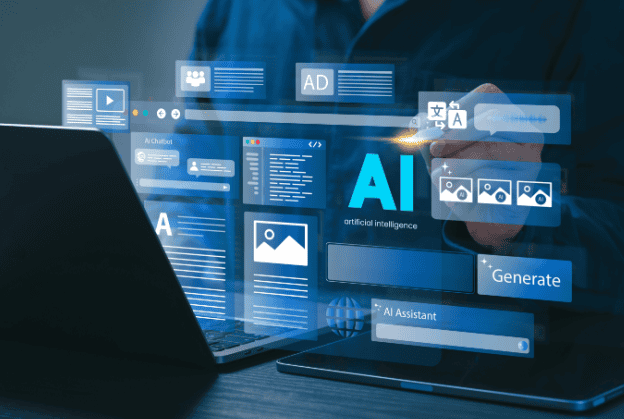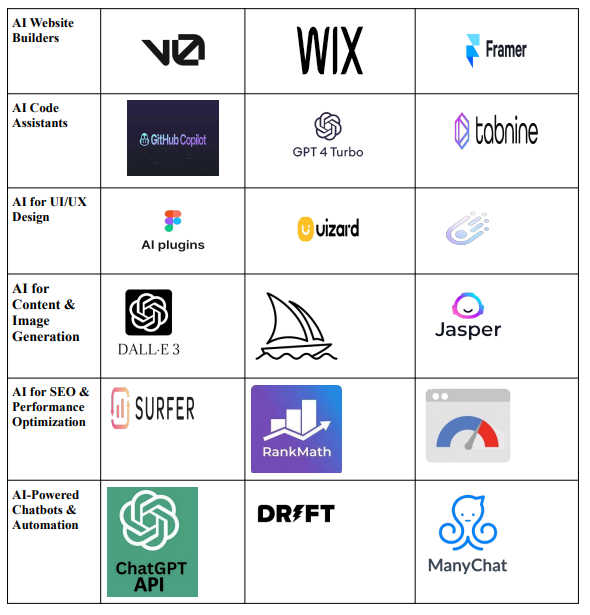Generative AI in Web Development: The Future is Now

Generative AI introduces a new method for web development which modifies the entire process of website designing and coding and performance optimization. AI-powered tools have transformed the creation process through automated UI/UX design together with content generation functions to optimize search engine results which speeds up developer creation of custom web environments. The future has arrived to our daily lives bringing what was ahead of us since this time continues today. The blog reveals how generative AI affects web development’s evolution as well as the implications for developers including businesses combined with end-users.
How Generative AI is Used in Web Development
- Code Generation
- Simple language inputs serve as instructions to AI systems including GitHub Copilot as well as ChatGPT so they can generate HTML, CSS, javascript and backend code.
- This tool speeds up development processes through both code creation assistance and recommendation functions.
- Website Design Automation
- Framer and v0 along with Wix ADI apply algorithms for automated website and UI design layout.
- Designers should make their responsive elements while building interfaces which match how users expect them to function.
- AI-Driven Content Generation
- The system produces blog content as well as product descriptions and SEO texts while generating automated chatbot responses.
- Lowers manual resource consumption on content creation at same standards.
- AI Chatbots & Virtual Assistants
- Users interact more effectively with AI-based chatbots including ChatGPT, Dialog Flow, Watson Assistant and their equivalents which simultaneously handle customer service tasks.
- The customer service team responds to standard questions and support needs and gives personalized recommendations.
- Automated Testing & Debugging
- The promo uses AI to inspect websites for bugs and accessibility problems as well as performance enhancements through testing.
- Testing frameworks that include AI technology together with Selenium enable development processes to speed up.
- Personalized User Experiences
- The strategic employment of AI allows applications to monitor user conduct and make continuous updates to website content and recommendation engines and UI aspects.
- Improves customer interaction and conversion rates.
- SEO & Performance Optimization
- The optimization system uses online ranking performance to enhance outcomes by adjusting both meta tags and page execution parameters and keywords.
- AI provides an opportunity to examine competitor websites so you can discover areas that need improvement.
- Generative UI & UX Design
- The platform executes real-time UI suggestions through artificial intelligence that studies industry movement and best plans.3
- The system facilitates creation of interactive web applications that demonstrate responsive functionality.
Capabilities of Generative AI in Web Design
- Creating user interfaces (UIs): The application of Generative AI enables users to obtain numerous UI designs from set requirements encompassing website purposes alongside audience profiles and style preferences. The process reduces the need for designer time and effort.
- Creating content: AI platforms such as ChatGPT, Jasper AI, and Copy. ai enable users to create website content alongside product texts and blog entries and social media texts. AI content generators help writers enhance both their work speed and audience understanding which results in better written material optimization. Through AI algorithm customization users achieve better engagement which results in increased conversion numbers.
- Optimizing websites for search engines (SEOs): AI performs this function with ease by examining website structures together with content to generate better search engine rankings. Surfer SEO and Rank Math AI serve as examples that help users find keywords and enhance meta tags and content readability to achieve better SEO results. AI provides benefits to site ranking on search engines because it enables essential schema markup generation alongside fast site speeds and improved user experience.
Examples of generative AI tools for web design:- Auto Layout ,Contentful ,CopyAI ,Surfer SEO.
Advantages of Using Generative AI in Web Development
1. Faster development and less workload
The automated system shows high effectiveness for writing scaffold or boilerplate code and producing UI components while executing simple logical functions which leads to reduced development time. The AI code assistants GitHub Copilot together with ChatGPT assist developers to write and enhance code at increased speed. The automation system allows teams to concentrate on important work that speeds up project completion.
2. Cost Efficiency
The automatic implementation of AI for coding combined with testing and debugging functions decreases the requirement for human workforce and thus minimizes labor expenses. AI functions enable companies to finish projects at reduced operating expenses through reduction of mistake costs and rework spending.
3. AI-Powered Personalisation and User Experience
The system uses AI technology to study user behaviors together with offered preferences to display customized recommendations along with adaptive interfaces and dynamic content. The combination of several useful elements includes AI chatbots for interactive assistance and voice assistants together with smart UI features that adapt to temperature and weather changes within the app.
4. Improved Code Quality and Debugging
The code development process receives support from Generative AI through automated code recommendations alongside security analysis and automatic bug resolution features. Developers gain a more secure and better maintainable code base through the combination of both automated code review systems and AI tools for refactoring.
5. SEO and Performance Optimization
AI tools successfully acquire the top search result position by analyzing web page structure combined with keyword density and SEO technical elements. AI tools enhance performance targeting through automated code reductions and resource-streamlined delivery and responsive design system adaptation.
6. AI-Generated Content and Images
Through generative AI technology websites obtain premium content such as text alongside visuals alongside videos which reduces the need for human creators of website designs and content materials. The system enables both content acceleration alongside brand element uniformity.
7. Enhanced Accessibility and Compliance
Artificial Intelligence enables websites to become more accessible because it generates alt text and improves contrast levels while providing voice navigation options. Your website enhancements will adhere to both WCAG (Web Content Accessibility Guidelines) and GDPR standards as per the requirement.
8. Predictive Analytics and Data Driven Decisions
User data processing enables AI to forecast trends which delivers better UX features for users along with enhanced marketing discussion. The AI-based analysis capabilities of Web design and customer journeys provide joint assistance to business objectives and technology development.
9. Scalability and Flexibility
Managing web domains while handling increasing traffic with complex work presents specific difficulties in server optimization and database administration.
10. Competitive advantage.
The deployment of AI during application development guarantees advanced user experiences to customers which grants major advantages for organizations in their competitive landscape.The integration of automated procedures with optimization systems and personalized functions generated using AI tools enables organizations to achieve superiority in their market competition.
Challenges of Using Generative AI for Web Development
Lack of complete creative control:AI operational tools pose limitations to developers during project development because they function based on predefined patterns and algorithms. Such projects normally omit the personalized features built specifically to meet individual requirements or demands.
Quality and Accuracy Issues: AI systems automatically generate many different outputs yet the produced content often needs manual correction because it contains inaccuracies as well as poor quality. This method creates difficulties in precise applications because accuracy is vital.
Dependency on AI Models and Tools: Excessive use of AI tools throughout development operations creates substantial dependency on AI models for developers. Work development and tool selection decisions would be disrupted by both unpredictable behavior of AI tools and emerging access problems.
Security and Privacy Concerns:The security vulnerabilities along with data mishandling issues which several AI applications, especially content generation programs may encounter primarily stem from unverified training data or when the programs are built specifically to bypass data protection systems.
SEO and Content Limitations: When generating content assisted by AI there is no certainty that the outcomes will be optimal for search engine optimization. AI lacks specific SEO techniques that might result in poorly ranked information as well as content that does not match user expectations.
Integration and Compatibility :The process of including AI-generated tools and components into current web projects may prove difficult to implement. Compatibility problems emerge from the integration of AI models into existing systems using frameworks or other programs due to improper integration failures.
Cost of AI Tools and Services: AI solutions come with both cost-free versions and more advanced tools that require expensive subscription fees and usage expenses. Project costs become significantly expensive because these fees accumulate throughout multiple project cycles regardless of project scale or complexity.
Limited Problem-Solving Capability: The application of AI-generated tools coupled with web project components makes implementation steps more complicated to execute. AI models cause compatibility problems during integration because they display limited effectiveness when interfacing with existing programming systems.
Web Development Using Generative AI Tools


5 things that students in the software or IT industry should know:
- AI Agency Software
- Multimodality
- Retrieval-Augmented Generation (RAG)
- Pretrained model creation
- Prompt Engineer
- AI agency software utilizes artificial intelligence to operate business operations through automation in marketing, sales, customer service and other areas. CRM systems along with artificial intelligence and chatbots and lead generation tools operate as operational tools which create efficient business processes and reduce operational complexities. Students require knowledge about AI agency functionality along with training in AI implementation for better business solutions that maximize productivity.
- Artificial intelligence models must process different data types such as text and images and audio and video due to the essentialness of multimodality as a concept. OpenAI operates GPT-4 Vision within the multimodal model domain alongside Google’s Gemini development and Meta’s work on their AI models. The essential tools for developing AI assistants together with chatbots and content creation tools require capabilities for handling various input types.
- Retrieval-Augmented Generation (RAG) systems implement hybrid approaches to combine retrieval-based search methodologies with generative AI functions for a process that obtains vital database information before generating their responses. RAG boosts the quality and operational speed of search engines alongside chatbots as well as knowledge-based systems.
- The process of creating pretrained models includes AI model training on extensive datasets that enable future modifications for particular tasks. Efficient development of AI applications requires knowledge about models including GPT, BERT and Stable Diffusion.
- The last step in artificial intelligence development involves prompt engineering for designing prompts that effectively generate expected outputs from AI models. Large language models such as GPT require optimal prompt engineering for their successful operation while the technique stands as vital for developing chatbots and content generation and automation through AI.
Conclusion
The technology which was once only seen as future jargon now serves as a fundamental power force that assists humans in generating web content and web experiences. AI tools are set to benefit the development workflow during October 2023 along with improved web technology scalability and adaptability through these changes which begin at user interaction and extend to SEO capabilities. To reach this potential the essential security concerns together with accuracy risks as well as creative control challenges must be adequately addressed.
The hotly discussed field of Prompt engineering has rapidly gained popularity because developers want to combine AI benefits with minimal time consumption and maximum efficiency. SLMs transform standards across all domains with their economic AI solutions that provide either performance improvements or equivalent ability at the level of large system architectures.
Laboratory testing has shown that adaptable developers will become future web development leaders who establish innovative generations of web applications capable of developing intelligent software solutions. The assistance provided by AI tools raises an important concern about code memorization among programmers because they may forget essential programming tasks thus their basics need attention.
What do you think about the impact of Generative AI in Web Development? Let us discuss in the comments!

